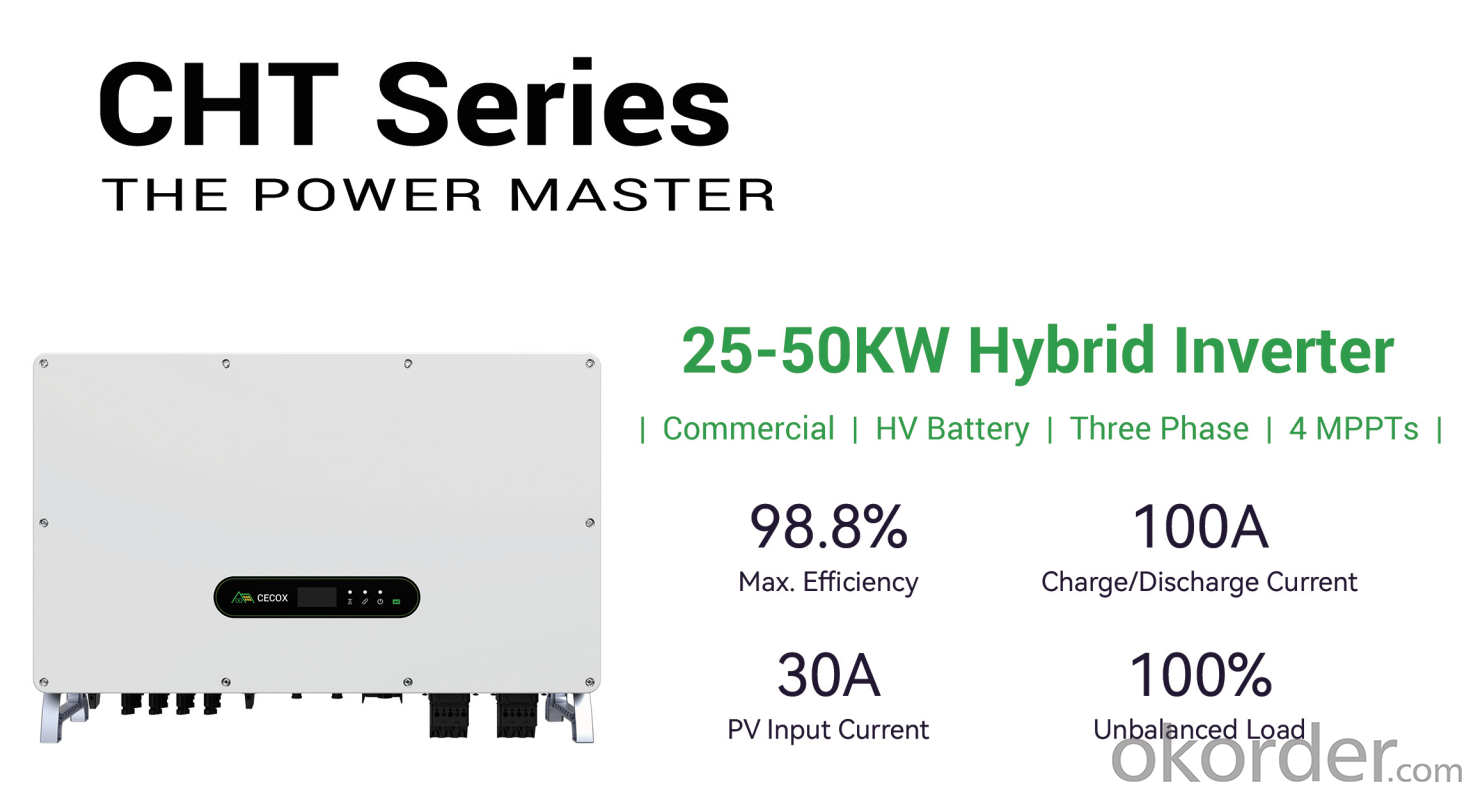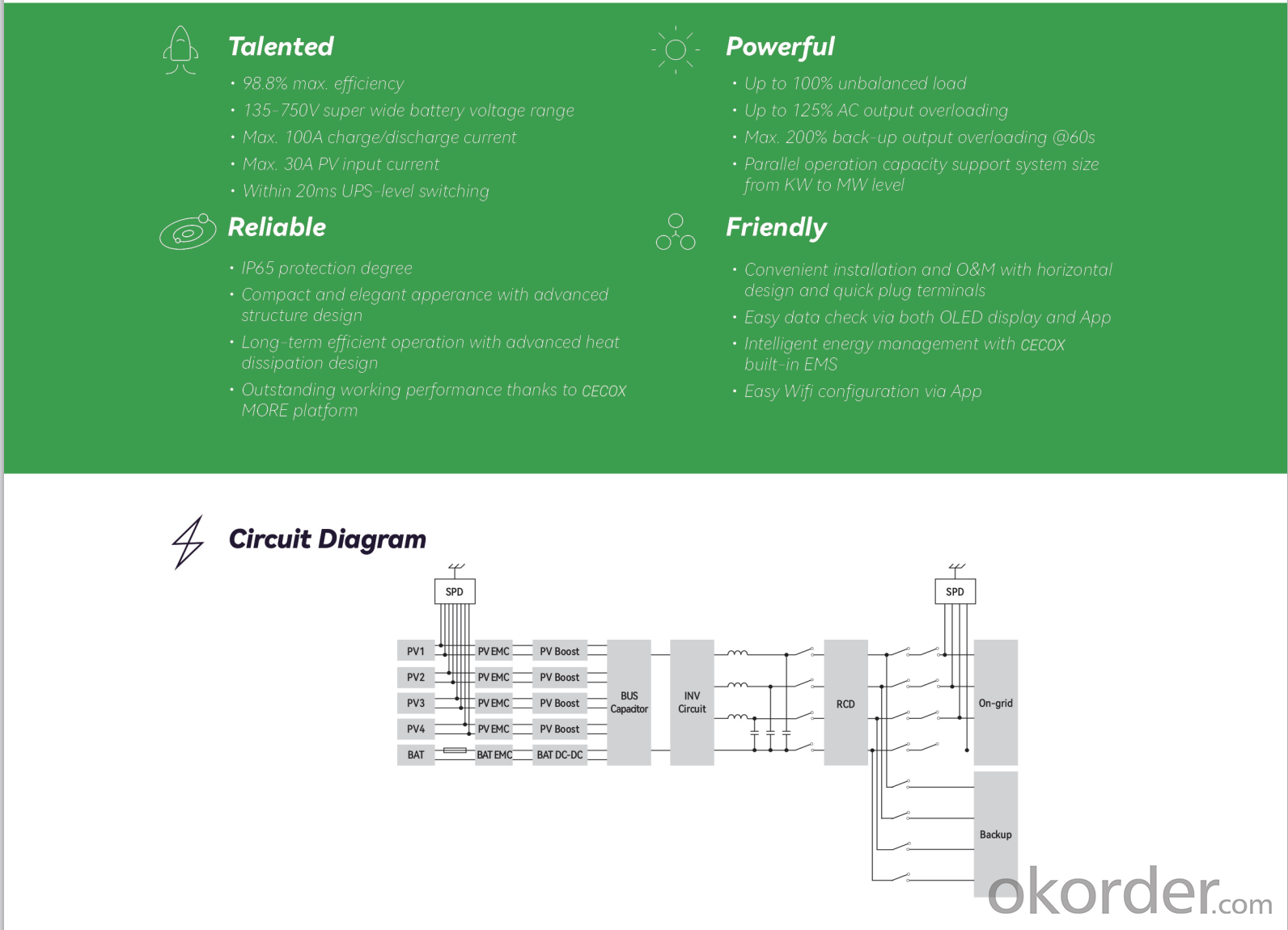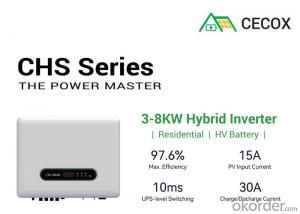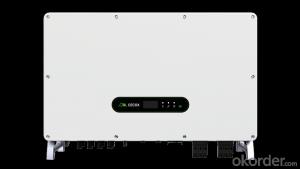Three Phase Solar 25kw 30kw 36kw 40kw50kw high voltage hybrid inverter Best Selling good price
- Loading Port:
- Stock in Panama
- Payment Terms:
- TT or LC
- Min Order Qty:
- 1 unit
- Supply Capability:
- 5000 unit/month
OKorder Service Pledge
Quality Product, Order Online Tracking, Timely Delivery
OKorder Financial Service
Credit Rating, Credit Services, Credit Purchasing
You Might Also Like
Item specifice
Output Power:
50kw
Inveter Efficiency:
98.8%
Output Voltage(V):
220/380v,230V/400V,240/415V
Input Voltage(V):
1000v
Output Current(A):
100A
Output Frequency:
50/60HZ



- Q:What is the maximum operating altitude for a solar inverter?
- The maximum operating altitude for a solar inverter can vary depending on the specific model and manufacturer. However, most solar inverters are designed to operate effectively up to an altitude of around 2,000 meters or 6,500 feet above sea level. It is important to consult the manufacturer's specifications for the specific model to determine the exact maximum operating altitude.
- Q:Can a solar inverter be easily integrated into an existing electrical system?
- Yes, a solar inverter can be easily integrated into an existing electrical system. Solar inverters are designed to seamlessly connect with the existing electrical infrastructure of a building or property. They can be installed alongside the main electrical panel and connected to the grid, allowing the solar energy generated by the panels to be converted into usable electricity for the building's consumption. With the help of a qualified electrician or solar installer, the integration process can be straightforward and efficient.
- Q:How do you choose the right size of solar inverter for a system?
- To choose the right size of solar inverter for a system, several factors need to be considered. Firstly, you should determine the total capacity of the solar panels in the system. The inverter's maximum input power rating should be equal to or slightly higher than the total capacity of the panels. Additionally, the inverter's voltage rating should match the system's voltage requirements. It is also crucial to consider the inverter's efficiency, as a higher efficiency rating will ensure better conversion of solar energy into electricity. Lastly, it is advisable to consult a professional or use online calculators to accurately determine the appropriate size of the inverter based on the specific needs and requirements of the system.
- Q:Are there any maintenance requirements for solar inverters?
- Yes, solar inverters do require regular maintenance to ensure optimal performance and longevity. This can include cleaning or replacing air filters, inspecting and tightening electrical connections, checking for any physical damage or corrosion, and updating firmware or software as needed. Additionally, monitoring the inverter's performance and generating reports can help identify any issues or inefficiencies that may require maintenance or repairs.
- Q:Can a solar inverter be used with a solar-powered water heating system?
- Yes, a solar inverter can be used with a solar-powered water heating system. The solar inverter converts the direct current (DC) generated by the solar panels into alternating current (AC) that can be used to power the water heating system. This allows for efficient utilization of solar energy and ensures the water heating system operates effectively.
- Q:Can a solar inverter be used for off-grid applications?
- Yes, a solar inverter can be used for off-grid applications. Off-grid systems typically rely on solar panels to generate power, and a solar inverter is used to convert the direct current (DC) produced by the panels into alternating current (AC) which can be used to power appliances and devices. The inverter also helps regulate the flow of electricity and ensure compatibility with off-grid power storage systems such as batteries.
- Q:What is the role of a solar inverter in a solar-powered water purification system?
- The role of a solar inverter in a solar-powered water purification system is to convert the direct current (DC) electricity generated by the solar panels into alternating current (AC) electricity, which is then used to power the water purification system. The solar inverter ensures that the electricity produced by the solar panels is compatible with the electrical requirements of the water purification system, allowing it to function efficiently.
- Q:How does a solar inverter handle power quality issues in the grid?
- A solar inverter helps to handle power quality issues in the grid by continuously monitoring the voltage and frequency of the grid. If it detects any variations or deviations from the standard levels, it adjusts its own output accordingly to maintain a stable and reliable power supply. Additionally, some advanced solar inverters also incorporate features like power factor correction and voltage regulation to further enhance power quality and ensure efficient utilization of the solar energy generated.
- Q:How does a solar inverter handle voltage and frequency variations caused by switching operations?
- A solar inverter is designed to handle voltage and frequency variations caused by switching operations through its built-in control mechanisms and advanced technology. When a solar inverter is connected to the grid, it monitors the voltage and frequency of the grid and adjusts its operation accordingly to maintain stability and safety. In the case of voltage variations caused by switching operations, a solar inverter typically employs a voltage control mechanism. This mechanism continuously monitors the voltage level of the grid and adjusts the output voltage of the inverter to match the grid voltage. If the grid voltage rises or falls beyond a certain threshold, the inverter automatically adjusts its output voltage to compensate and maintain a stable voltage level. Similarly, for frequency variations caused by switching operations, a solar inverter utilizes a frequency control mechanism. This mechanism constantly monitors the grid frequency and adjusts the inverter's output frequency to match the grid frequency. If the grid frequency deviates from the standard frequency, the inverter can quickly respond by adjusting its output frequency to maintain synchronization with the grid. To achieve this level of control, solar inverters often incorporate advanced digital signal processing algorithms and sophisticated control systems. These algorithms and control systems analyze the voltage and frequency signals from the grid, and based on predefined parameters, make rapid adjustments to the inverter's output to ensure compatibility with the grid. Ultimately, the goal of a solar inverter is to seamlessly integrate with the grid and provide a stable, reliable, and efficient power supply. By effectively handling voltage and frequency variations caused by switching operations, the inverter contributes to the overall stability and resilience of the grid, allowing for optimal utilization of solar energy and promoting a sustainable energy future.
- Q:Can a solar inverter be upgraded or expanded in the future?
- Yes, a solar inverter can be upgraded or expanded in the future. Inverter technology is constantly evolving, and manufacturers often release firmware updates or offer hardware upgrades to improve performance, add new features, or increase capacity. Additionally, in case of increased energy demands or the addition of more solar panels, it is possible to expand the system's capacity by adding additional inverters or upgrading the existing inverter to a higher capacity model.
1. Manufacturer Overview |
|
|---|---|
| Location | |
| Year Established | |
| Annual Output Value | |
| Main Markets | |
| Company Certifications | |
2. Manufacturer Certificates |
|
|---|---|
| a) Certification Name | |
| Range | |
| Reference | |
| Validity Period | |
3. Manufacturer Capability |
|
|---|---|
| a)Trade Capacity | |
| Nearest Port | |
| Export Percentage | |
| No.of Employees in Trade Department | |
| Language Spoken: | |
| b)Factory Information | |
| Factory Size: | |
| No. of Production Lines | |
| Contract Manufacturing | |
| Product Price Range | |
Send your message to us
Three Phase Solar 25kw 30kw 36kw 40kw50kw high voltage hybrid inverter Best Selling good price
- Loading Port:
- Stock in Panama
- Payment Terms:
- TT or LC
- Min Order Qty:
- 1 unit
- Supply Capability:
- 5000 unit/month
OKorder Service Pledge
Quality Product, Order Online Tracking, Timely Delivery
OKorder Financial Service
Credit Rating, Credit Services, Credit Purchasing
Similar products
New products
Hot products
Hot Searches
Related keywords































